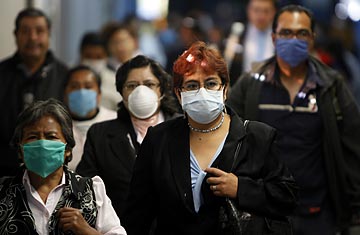
Residents of Mexico City wear masks as they exit the city's subway system.
The empty cordoned-off seats in Mexico City restaurants signal the latest attempt to stop the killer swine flu virus from spreading. Mayor Marcelo Ebrard on Tuesday ordered that the eateries serve take-out food only. He also called for the shut-down of other places where people could mingle: gyms, swimming pools and sports halls. Others on the long list of closed spaces: bars, discos, stadiums, museums, theaters, cinemas, church masses and of course, schools and universities. Any non-essential place where the public can meet, have fun and spread disease is off limits.
These containment tactics in the Mexican capital are being closely watched in cities across the world from Los Angeles to New York, where swine flu is also slowly seeping through the streets. But how are policy makers going to judge Mexico City's shutdown response to the outbreak: as a model for slowing infections; or an ineffective recipe that might bring about economic disaster? (See pictures of how Mexico has been affected by swine flu.)
Rafael Camarena, a Mexico-City based analyst for Banco Santander of Spain, is convinced that government's strong-arm tactics will prove that Mexican authorities, criticized for ineffectiveness on other issues, can make the tough decisions — even if the virus threat proves to be exaggerated. "The authorities are being decisive and firm. This will help the economic damage be a short term thing and build up confidence in Mexico," Camarena says. However, for many in the service sector, the mayor's crackdown is seen as the equivalent of a nuclear attack on their already struggling businesses. Daniel Loeza, vice-president of the restaurant association, said the order to sell only takeout food will put 450,000 waiters, dishwashers and other staff out of work, increasing economic pressure that could push Mexico over the edge. (Read a story of how travel and tourism was affected the first weekend of the swine flu outbreak.)
It is hard to calculate exactly how many of these tactics have helped stop the virus from spreading. In the first four days following April 24 when the government started taking action, the number of infected and dead rose steadily — from 58 reported fatalities on Friday to 149 dead by the tally on Monday. The total number of people who have been hospitalized for the infection shot up to more than 2,000, although two-thirds of these had checked out after successfully responding to anti-viral drugs. (Read a story about how the U.S. is preparing a swine flu vaccine.)
Much of the evaluation of the city's shutdown has been overshadowed by mounting criticism on the federal government for letting the virus get out of control in the first place. After alleging the first fatality from swine flu was a 39-year-old woman from the poor southern Mexican state of Oaxaca who died on April 13, Health Secretary Jose Córdova conceded that Edgar Hernandez, a four-year-old boy, who survived a bout of flu in February and March, had actually had the virus, as tests have now shown. Local authorities had raised alarm bells about a potent outbreak of flu in the boy's village, La Gloria, but the federal government had not reported the development to the World Health Organization. Officials considered the child's illness "normal," having occurred during the flu season.
Peppered with questions about the issue in a tense press conference, Córdova responded that there had been mixed signals from the flu epidemic in La Gloria and most who had taken ill had suffered from a familiar form of the influenza virus. He also said the government had no model of the H1N1 virus — which has features of avian, pig and human viruses — to base their studies on. "We never had this kind of epidemic in the world," he said on Monday. "This is the first time we have this kind of virus." As if to underline the point, the conference and Mexico City were rocked by tremors from a 6.0 magnitude earthquake with an epicenter in the state of Guerrero.
The La Gloria outbreak may also give clues about the origins of the virus. The community is a few miles from an industrial pig farm Granjas Carroll de Mexico, which is 50% owned by Virginia-based Smithfield Foods, Inc. Residents have complained for several years about effluent — composed of animal waste and porcine feces — dumped by the farm and accuse it of making them fall sick. However, government agricultural experts joined the company in saying they have found no traces of swine flu in its hundreds of workers or thousands of hogs and piglets.
Whatever the origins, the virus is putting increasing pressure on the capital city. After his Tuesday announcements about restaurants, Ebrard said that if the number of sick rises drastically, he will consider still harder methods such as shutting down the subway system — a move that would really send shockwaves through the economic backbone of the capital. "We need to work together and be responsible," the mayor said. "We are going to defeat this challenge as we have done with all the other difficulties that our city has faced."
